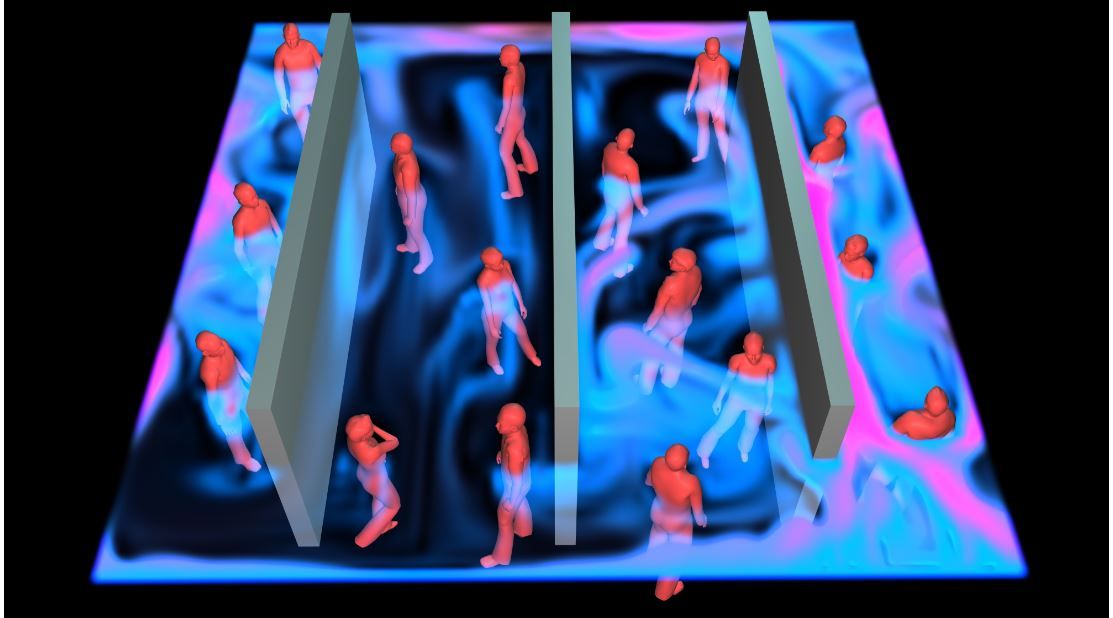An international group of scientists is planning to ask the World Health Organization (WHO) to revise its guidance on how the COVID-19 virus is transmitted and on measures to control its spread.
The scientists, representing 32 countries, are expected to publish the request as an open letter in the journal Clinical Infectious Diseases. The letter will offer evidence to support the position that the disease is airborne and travels through small particles that persist and are infectious, according to the New York Times.
The WHO's position is that COVID-19, the disease caused by the SARS-CoV2 virus, is primarily transmitted through large, weighty respiratory droplets that descend to the floor quickly after discharge from a cough or sneeze.
In a scientific brief published on the agency's web site at the end of March, the WHO said that transmission of the COVID-19 virus can occur through person-to-person contact and through indirect contact with surfaces in the immediate environment of an infected individual.
A segment of the scientific community says evidence shows that the virus is borne through the air and can infect individuals upon being inhaled, the Times reported, noting that small particles can travel quickly following a sneeze. Exhaled droplets of the virus can travel more gradually the length of a room, some scientists say.
A draft of the letter reads, in part: "We appeal to the medical community and to the relevant national and international bodies to recognize the potential for airborne spread of COVID-19. There is significant potential for inhalation exposure to viruses in microscopic respiratory droplets (microdroplets) at short to medium distances (up to several meters, or room scale), and we are advocating for the use of preventive measures to mitigate this route of airborne transmission." (See sidebar)
Measures to Mitigate Airborne Virus Transmission
·Provide sufficient and effective ventilation (supply clean outdoor air, minimize recirculating air) particularly in public buildings, workplace environments, schools, hospitals, and aged care homes.
·Supplement general ventilation with airborne infection controls such as local exhaust, high efficiency air filtration, and germicidal ultraviolet lights.
·Avoid overcrowding, particularly in public transport and public buildings.
The letter cites studies conducted by its signatories and by other scientists that they say "demonstrate beyond any reasonable doubt that virusesarereleased during exhalation, talking, and coughing in microdroplets small enough to remain aloft in air and pose a risk of exposure at distances beyond 1to 2 m from an infected individual."
The authors also point to data on the spread of other viruses, including respiratory syncytial virus, Middle East Respiratory Syndrome coronavirus, and influenza that show "viable" airborne viruses can be exhaled and also detected in indoor environments of persons who are infected.
Handwashing, distance not enough
Most public health organizations, the scientists say, currently do not recognize airborne transmission outside of aerosol-generating procedures performed in medical settings.
Handwashing and social distancing, the core of the WHO position on mitigating virus transmission, while acknowledged as appropriate tactics, are not enough protection against infectious respiratory microdroplets released into the air by infected persons. The problem is significantly pronounced in indoor or other enclosed environments, the letter emphasizes, and even more acute when those spaces are crowded and poorly ventilated.
In fact, it is situations exactly like these that are being blamed for the sudden, steep surge in COVID-19 infections being reported across the country as bars, clubs, and similar indoor gathering places have resumed service in recent weeks. Many of those states have reversed reopening plans.
WHO responds to letter from scientists on airborne transmission
The World Health Organization (WHO) acknowledged the emerging evidence of airborne spread of COVID-19 after an open letter by over 200 scientists gave evidence that the virus floated and remained suspended in the air.
“The possibility of airborne transmission in public settings – especially in very specific conditions, crowded, closed, poorly ventilated settings that have been described, cannot be ruled out,” said Benedetta Allegranzi, WHO’s technical lead for infection prevention and control, at a virtual WHO press conference.
“However, the evidence needs to be gathered and interpreted, and we continue to support this,” she added.
Recognizing the danger of airborne transmission could potentially impact response efforts, for example, making masks required in any indoor setting, even if social distancing is maintained. Surgical masks would likely not be acceptable any longer in healthcare settings, with workers being required to wear N95 masks capable of filtering out the infected microdroplets.
Benedetta Allegranzi, technical lead on infection control for the WHO, told the New York Times that there is still a lack of solid evidence on airborne transmission.
“Especially in the last couple of months, we have been stating several times that we consider airborne transmission as possible but certainly not supported by solid or even clear evidence,” she said. “There is a strong debate on this.”
Letter signatories acknowledge that the evidence for microdroplet transmission is incomplete -- but that the same is true for the large droplet and fomite transmission. Importantly, they assert, these mechanisms are not mutually exclusive and operate in parallel.
The scientists state:
"Following the precautionary principle, we must address every potentially important pathway to slow the spread of COVID-19."
The WHO on Saturday, July 4th, reported more than 200,000 cases of the virus, marking a new high in infections over a 24-hour period.
As of Sunday, health officials had reported more than 11 million cases of COVID-19 and roughly 530,000 deaths stemming from it worldwide, according to a Johns Hopkins University database.

